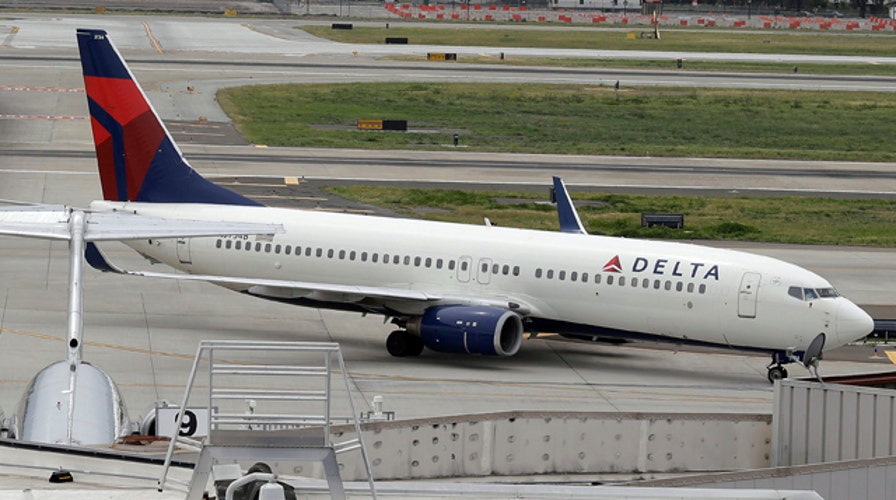Airport authorities in San Jose, California were attempting to determine Monday how a runaway teenager made his way onto an airport tarmac before slipping into the wheel well of a Maui-bound plane.
The 16-year-old boy survived temperatures estimated to be around 80 degrees below zero at 38,000 feet, as well as a lack of oxygen during the five-and-a-half hour flight. Authorities found the high school student wandering the Maui airport grounds Sunday with no identification. He was questioned by the FBI and taken by ambulance to a hospital, where he was found to be unharmed.
FBI spokesman Tom Simon in Honolulu told the Associated Press that the teen climbed into the left rear wheel well of the first plane he saw in San Jose.
"He got very lucky that he got to go to Maui but he was not targeting Maui as a destination," said Simon, who added that the teen passed out in the air and didn't regain consciousness until an hour after the plane landed.
Some aviation experts are questioning how the boy could have survived.
"Within a few minutes up at that altitude, the person would pass out and usually they would not survive for hours on end up there so it just boggles the mind," aviation analyst Peter Forman told Hawaii News Now. "You would suffocate most likely up there. It's extremely unlikely that somebody would survive that long at that altitude. And if they did survive, you would think that they would have frostbite and all sorts of problems associated with the cold up there."
On Monday, authorities tried to determine how the boy slipped through multiple layers of security, including wide-ranging video surveillance, German shepherds and Segway-riding police officers.
Security footage from the San Jose airport verified that the boy climbed a fence and crossed a runway to get to Hawaiian Airlines Flight 45 on Sunday morning, Simon said.
That airport, in the heart of Silicon Valley, is surrounded by fences, although many sections do not have barbed wire and could easily be scaled.
The boy climbed over during the night, "under the cover of darkness," San Jose airport spokeswoman Rosemary Barnes said Monday.
Hours later, surveillance video at Kahului Airport showed the boy getting out of the wheel well after landing, according to a statement from Hawaii's Department of Transportation. The video was not released because of the ongoing investigation.
Hawaiian Airlines spokeswoman Alison Croyle said airline personnel noticed the boy on the ramp after the flight arrived and immediately notified airport security.
"Our primary concern now is for the well-being of the boy, who is exceptionally lucky to have survived," Croyle said.
Isaac Yeffet, a former head of security for the Israeli airline El Al who now runs his own firm, Yeffet Security Consultants, said the breach shows that U.S. airport security still has weaknesses, despite billions of dollars invested.
"Shame on us for doing such a terrible job," he said. "Perimeters are not well protected. We see it again and again."
A congressman who serves on the Homeland Security committee wondered how the teen could have sneaked onto the airfield unnoticed.
"I have long been concerned about security at our airport perimeters. #Stowaway teen demonstrates vulnerabilities that need to be addressed," tweeted Rep. Eric Swalwell, a Democrat who represents the San Francisco Bay Area's eastern cities and suburbs.
Unlike checkpoint security inside the airport, which is overseen by the Transportation Security Administration, airport perimeters are policed by local authorities, as well as federal law enforcement.
Airport police were working with the FBI and the TSA to review security.
The boy was released to child-protective services in Hawaii and not charged with a crime, Simon said.
The city of San Jose, which owns and operates the California airport, is not planning on pursuing criminal charges against the teen based on the current information available.
The FAA says 105 stowaways have sneaked aboard 94 flights worldwide since 1947, and about 1 out of 4 survived. But agency studies say the actual numbers are probably higher, as some survivors may have escaped unnoticed, and bodies could fall into the ocean undetected.
In August, a 13- or 14-year-old boy in Nigeria survived a 35-minute trip in the wheel well of a domestic flight after stowing away. Authorities credited the flight's short duration and its altitude of about 25,000 feet. Others who hid in wheel wells have died, including a 16-year-old killed aboard a flight from Charlotte, N.C., to Boston in 2010 and a man who fell onto a suburban London street as a flight from Angola began its descent in 2012.
An FAA review of high-altitude wheel well survivors said they typically clamber past the main landing gear into a wing recess area next to where the gear retracts. On some aircraft, that space is large enough for two small adults.
The FAA found that all wheel-well stowaways will lose consciousness at high altitude from lack of oxygen, and that their freezing bodies go into a state somewhat similar to hibernation.
The Associated Press contributed to this report.


